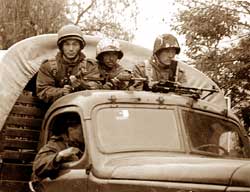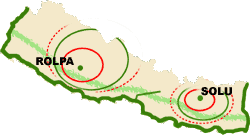 "When the enemy attacks, withdraw from the battlefield."
"When the enemy attacks, withdraw from the battlefield."
"Draw the enemy to fight you on your terrain."
"Attack and then disperse like bees."
These battle tactics perfected by Mao Zedong were behind recent Maoist attacks in Dang, Syangja and Solu. And from the looks of it, the tactics worked well. It brought out the Royal Nepal Army, which is now pursuing the Maoists into the hinterland in a classic guerrilla engagement.
Maoist movements across the world learn military organisation from Clausewitz and war strategy from Mao, who himself borrowed from Sun Tzu. But our Maoists have also learnt from the experiences of their comrades in similar Third World settings from the Peruvian Shining Path, India's Maoists and the Sri Lankan JVP uprising. All of these provide some insight into their current strategy.
Rolpa is the centre of Maoist influence in the mid-west, but the rebels do not have a similar stronghold in the east. This is why the attack on Salleri assumes significance. Solu has strategic importance mainly due to difficult terrain, the region's ethnic diversity and the fact that government presence on the ground is relatively thin. The attack could be part of a larger plan to draw the army out east, relieve some of the pressure from the mid-west and ultimately encircle them from the surrounding districts of Okhaldhunga, Khotang and Dolakha. That would be similar to the purpose of the raid on the army base in Dang on 23 November, hoping that the army would follow them to Rolpa and Rukum, which they did.
If that is the ultimate strategy, a scenario can be envisaged in which the Maoist centres in Solu and Rolpa would be cordoned off by the army. This army cordon would be surrounded by a weaker Maoist encirclement, which itself would be guarded by an outer military periphery. Soon enough, holes will emerge in these concentric circles, and as each side tries to break the other's cordon these areas will become the focus of future battles. The Maoists will be fighting from the inside, from territory they are familiar with and where they have popular support, while the security forces will be fighting from the outside in, and relying on air support and logisitical flexibility.
The Maoists are on the defensive, so they will try to trap the army, block its supply lines and drinking water, all to wear them down and force them to make mistakes. The army for its part will play a cat and mouse game with the Maoists, chasing them and keeping them on the move. This movement will be an important factor-it can help force the enemy to surrender or divide, possibilities Mao also wrote about. The army will move to spread the dragnet nationwide. In such a situation, the Maoists would have two options: either break the net and escape, or just lie low. What follows will also be determined by how capable the army is and the security situation along and across the border in India.
 Due to considerations of topography, the Maoists have made the Mahabharat midhills their horizontal battle line or sphere of influence. Government security forces, on the other hand, have delineated the battle zones based on vertical lines that mark development regions. At the points these lines intersect is where there is the possibility of fierce fighting in the offing. The Maoists will try to incite the army into killing large numbers of people at these points which will help sow dissent among opposition parties in Kathmandu and the war itself unpopular among Nepalis. This strategy could work.
Due to considerations of topography, the Maoists have made the Mahabharat midhills their horizontal battle line or sphere of influence. Government security forces, on the other hand, have delineated the battle zones based on vertical lines that mark development regions. At the points these lines intersect is where there is the possibility of fierce fighting in the offing. The Maoists will try to incite the army into killing large numbers of people at these points which will help sow dissent among opposition parties in Kathmandu and the war itself unpopular among Nepalis. This strategy could work.
The Maoists are employing three types of guerrilla actions: surprise attacks, mass attacks and mobile battles. They are now organising for mass attacks, dispersing soon after to defend their fixed positions. They suffered huge losses in Salleri because they failed in the defensive part of the strategy. Now, they are trying to keep the army confined to the district capitals while they organise and regroup in the villages. Mao said: "Attack and then disperse like bees." That is the present Maoist game-plan and because they are in a defensive mode they will follow a defend-attack-defend pattern.
Ultimately, when the army launches its major offensives in the villages, the Maoists will retaliate by striking urban targets, including the capital: destroying bridges, perhaps aiming at airports. That is what is called "great destruction" in their scheme of things, and such battles could determine their overall defeat or victory.
The army would like this war to be clean and quick. The emergency and the deployment of the army are detrimental to those who believe in democracy, but it is in the Maoists interest to extend the emergency. The longer it lasts, the more chances are that it will bring about changes in the national situation, which will be good for their overall political goals. A long war will be expensive and a drain on the government's already strained budget. The army therefore wants a decisive confrontational battle while it is in the Maoists' interests to delay confrontation and tire the soldiers out.
Then there is the psy-war aspect. On one side are possible atrocities by the state and on the other, the terror spread by Maoists. Information management and propaganda therefore become key in winning and keeping the hearts and minds of the people. The government will use available media during the emergency to spread its side of the story, while the Maoists could aim at destroying media institutions or even threaten families of servicemen and the police. On this front, they may not be as effective.
The battle strategy boils down to the well-known sword-and-shield formula. If the army seems to be depending on air strikes, the Maoists will focus on ambushing ground advances as happened this week in Lamjung. Aerial attacks from bullet-proof helicopters could cause heavy Maoist casualties, and they have only two ways to tackle that: using human shields and being highly mobile. The army will be expected to use its air power for maximum advantage, especially in areas where roads are vulnerable to ambush and booby traps.
The army is now in a "cordon and destroy" mode, to which the Maoists are responding by trying to penetrate the encirclement. And as the army goes for guerrilla warfare, the Maoists will necessarily melt into the population and attack disguised as civilians. The Maoists had effectively defeated the Nepal Police in the past six years. By attacking the army in Dang, the Maoists flung their guantlet. Many battles lie ahead, and a lot will depend on the effectivity of the army's response.
(Puskar Gautam is a former Maoist area commander for Okhaldhunga and left the movement three years ago due to internal conflict with the leadership. A version of this article first appeared in Himal Khabarpatrika.)


